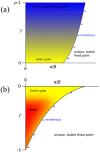The prevalence of chaotic dynamics in games with many players
- PMID: 29559641
- PMCID: PMC5861132
- DOI: 10.1038/s41598-018-22013-5
The prevalence of chaotic dynamics in games with many players
Abstract
We study adaptive learning in a typical p-player game. The payoffs of the games are randomly generated and then held fixed. The strategies of the players evolve through time as the players learn. The trajectories in the strategy space display a range of qualitatively different behaviours, with attractors that include unique fixed points, multiple fixed points, limit cycles and chaos. In the limit where the game is complicated, in the sense that the players can take many possible actions, we use a generating-functional approach to establish the parameter range in which learning dynamics converge to a stable fixed point. The size of this region goes to zero as the number of players goes to infinity, suggesting that complex non-equilibrium behaviour, exemplified by chaos, is the norm for complicated games with many players.
Conflict of interest statement
The authors declare no competing interests.
Figures







References
-
- von Neumann J, Morgenstern O. Theory of Games and EconomicBehaviour. Princeton NJ: Princeton University Press; 2007.
-
- Farmer JD, Geneakoplos J. ‘The Virtues and Vices of Equilibrium and the Future of Financial Economics.’. Complexity. 2008;14:11–38. doi: 10.1002/cplx.20261. - DOI
-
- McLennan A, Berg J. The asymptotic expected number of Nash equilibria of two player normal form games. Games and Economic Behavior. 2005;51(2):264–295. doi: 10.1016/j.geb.2004.10.008. - DOI
-
- Berg J, Weigt M. Entropy and typical properties of Nash equilibria in two-player Games. Europhys. Lett. 1999;48(2):129–135. doi: 10.1209/epl/i1999-00456-2. - DOI
Publication types
LinkOut - more resources
Full Text Sources
Other Literature Sources

